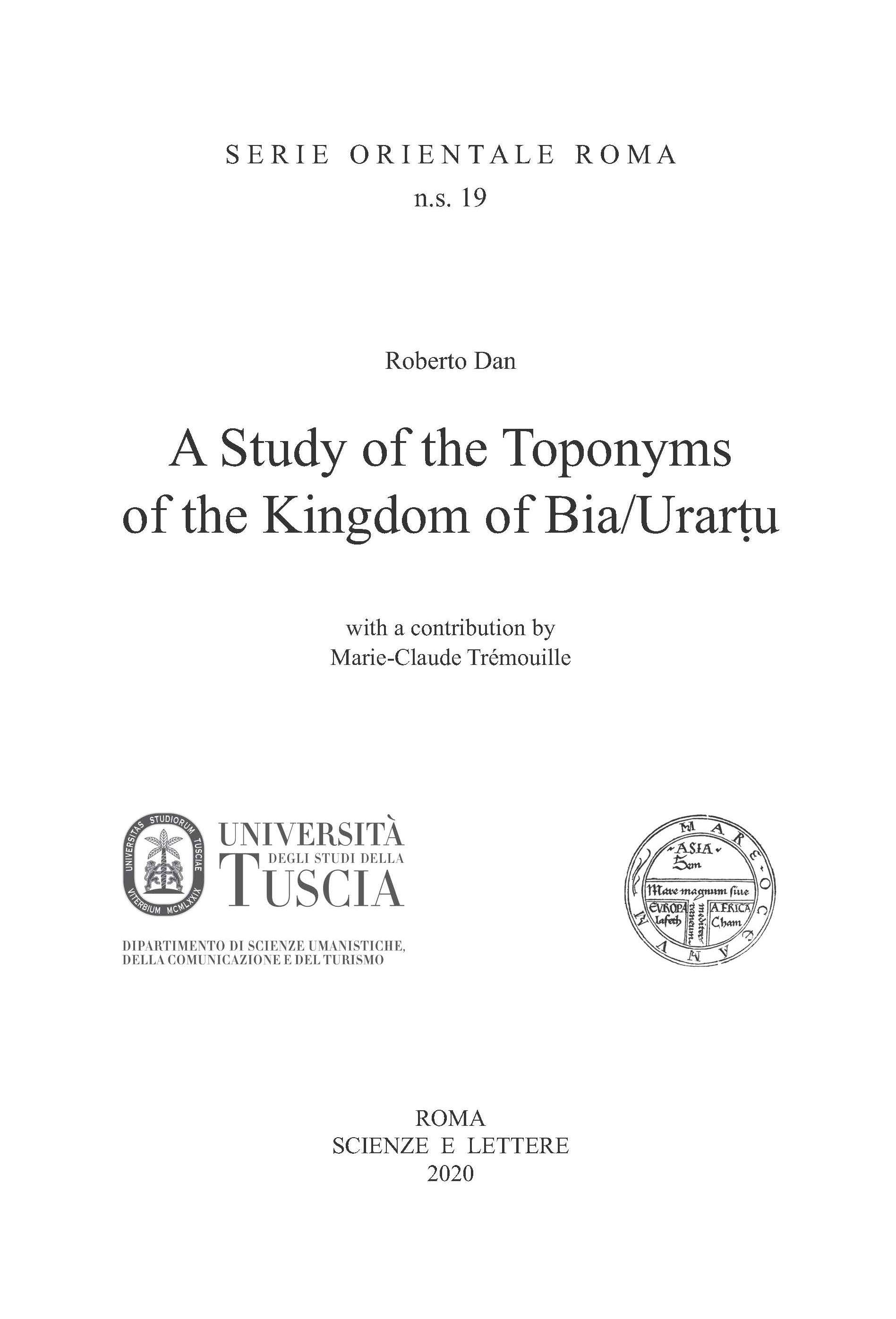A Study of the Toponyms of the Kingdom of Bia/Urartu - SERIE ORIENTALE ROMA n.s. 19
- Anno: 2020
- Autore/i: Roberto Dan with a contribution by Marie-Claude Trémouille
- Catalogo: Scienze e Lettere
- Argomento: Orientalistica
- Collana: Serie Orientale Roma
- ISBN: 9788866871859
- ISSN:
This volume by Roberto Dan is the second he has written in the Serie Orientale Roma N.S. The first study (From the Armenian Highland to Iran A Study on the Relations between the Kingdom of Urartu and the Achaemenid Empire, S.O.R. 4, 2015) focused on a systematic analysis of complex matters such as the “direct” and “indirect” relations between the state of Urar?u and the Achaemenid Empire, with a special focus on the so-called “Median transition,” a work that was aimed at historians, archaeologists and art historians.
This second volume is devoted to a study of Urartian toponomastics based on the publication of the Corpus dei Testi Urartei by Mirjo Salvini (five volumes, 2008-2018). It is jointly published by ISMEO and the Dipartimento di scienze umanistiche, della comunicazione e del turismo of the Tuscia University, Viterbo.
Part of the research has been conducted within the framework of a Research Fellows Program (“Urartu and the Achaemenids: archaeological and textual comparisons”) at DISUCOM, Tuscia University, PRIN Project “Territorio, ideologia, società: il continuum culturale in Iran dalla tarda età del ferro allo stato achemenide (ricerche archeologiche ed epigrafiche),” directed by Prof. Ela Filippone (2015RMKAFR_002).
In the volume, Roberto Dan has addressed the study of Urartian toponyms in a complete way for the first time since 1985, the year in which Nikolay Harutjunjan published his fundamental (now of course somewhat dated) monograph on this topic. The publication of this important work, which certainly constitutes considerable progress in Urartian studies, testifies to ISMEO’s commitment to become heir and developer of the “Urar?u Project” started years ago by Mirjo Salvini that has produced fundamental contributions to the discipline. This commitment is manifested not only by scientific publications in the field, but above all by the three archaeological projects carried out in coollaboration with local scholars and institutions by R. Dan in the Southern Caucasus, Armenia (Kotayk Survey Project, Vayots Dzor Project) and Georgia (Samtskhe-Javakheti Project), that in 2018 saw the creation of a single label under which all these activities related to the same cultural area are grouped, the Archaeological Mission to South Caucasus - ISMEO (AMSC - ISMEO). This incessant field activity is reflected in the pages of this work, in the depth that can be offered by a scholar familiar not only with I parte - intro + preface LoghiLinea_Layout 1 14/07/2020 09:13 Pagina VII
the archaeology, history and history of art, but also with the philology of Urar?u and Assyria.
The book is divided into a series of sections whose main part is dedicated to the detailed analysis of every single toponym known in the Urartian documentation. These toponyms, considerably more numerous than in previous publications, have been subdivided on the basis of the determinative that precedes the name into categories such as rivers, mountains, countries, tribes and towns. A series of useful appendices enrich the volume, including the first systematic comparison between Urartian and Assyrian toponyms, a summary of the places that can be identified with modern locations, all the known geographical coordinates of inscriptions and the reconstruction, where possible, of the places of origin of erratic inscriptions. To conclude, this work is a welcome addition not only for those directly interested in the civilization of Urar?u, but for all scholars involved in the study of Assyria and the other actors in the complex political scenario that characterized the 1st millennium BC in Mesopotamia and in the mountainous lands located south of the Greater Caucasus chain.
ADRIANO V. ROSSI
President of ISMEO
CONTENTS
Foreword by Adriano V. Rossi
Preface by Gernot Wilhelm
Acknowledgements
Marie-Claude Trémouille, The Geography of the Kingdom of Bia/Urartu
INTRODUCTION .
URARTIAN TOPONYMS
Rivers (ÍD)
“Lands,” “Mountains” (KUR) Fragmentary and Acephalous
“Lands,” “Mountains” (KUR)
“Tribes” (M) Fragmentary
“Tribes” (M) and Cities with Royal Names
MUNUS
“Towns” (URU) Fragmentary
“Towns” (URU)
Theophore Toponyms (DINGIR)
Toponyms Without Determinatives
APPENDIXES
1. Chronological Table with Synchronisms between Assyrian and Urartian Kings
2. Urartian Toponyms Identified with Modern Places
3. List of Urartian Toponyms with a Certain or Possible Correspondence with Assyrian Toponyms
4. Locations of Urartian Inscriptions
5. Reconstruction of the Original Locations of Erratic Urartian Inscriptions and General List of Cited Toponyms
PLATES
BIBLIOGRAPHY
List of General Abbreviations
List of Bibliographical Abbreviations
Bibliography
INDEX
F.to 17x24, Brossura filo refe, pp. 352, Ill. B/N



